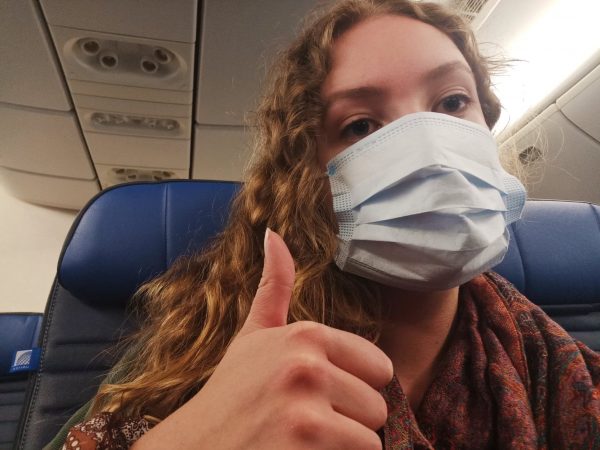As seen in the College of Liberal Arts Magazine | Winter 2020/ Spring 2021
Mapping People and the Environment
Joshua Zaffos
As the COVID-19 pandemic began unfolding in the United States last February, Zoe Schutte and other geography students at Colorado State University found themselves taking a different sort of Coronavirus test.
“We completed a disease mapping assignment where we all did our own research on various aspects of the pandemic, including ideas surrounding epidemiology, embodiment, fatality rate, and disease treatment and control,” said Schutte. “It was eye-opening for my personal understanding of the ways in which the virus impacts people socially, financially, mentally and physically.”

In the course Geography of Global Health (GR 305), Associate Professor Heidi Hausermann recognized a unique global-health lesson-in-motion and quickly worked to integrate events surrounding the COVID-19 pandemic into coursework.
“I think a lot about how vulnerabilities” – which may be related to age, race, gender, class or other factors – “and human-environment relations can combine to shape disease dynamics and infection, outbreaks, and incidence,” said Hausermann. “All of these same topics are huge as we are thinking about COVID-19.”
Launched in 2018, the Geography major teaches CSU students concepts and skills important to the field, such as applications with geographic information systems (GIS). Yet, Geography professors and students in CSU’s Department of Anthropology and Geography don’t just map physical spaces. Hausermann and other researchers of human geography observe and examine actual and theoretical interactions between people and environment, and how the distribution and movement of people, technology, and resources can affect societies and communities.
Hausermann assigned GR 305 students to explore the diversity and disparities in healthcare treatments and interventions surrounding the virus and the influence of cultural, economic and political conditions on how the pandemic was perceived and managed around the world. For instance, some students examined how COVID has been stigmatized across different countries and cultures and what that has meant for the acceptance of treatments or control measures. Others investigated the effects of closing wet markets where vendors sell live animals; places implicated in the initial transmission of the virus. In China and Asia, people rely on those markets for food and other goods.
GR 305 students explore the diversity and disparities in healthcare treatments and interventions surrounding the virus and the influence of cultural, economic and political conditions on how the pandemic was perceived and managed around the world.
Hausermann said she likes to challenge students to think about unintended impacts: A solution in one part of the world may present or exacerbate a problem somewhere else. “We can work COVID into discussions to think about geopolitics, globalization, environmental justice, or neoliberalism,” Hausermann said. “It is a good moment to make theory accessible.”
Hausermann’s own research operates at the intersection of gender, health, and environment. Her recent work in Ghana examines how rural people access treatment when conventional Western medicine is unavailable or undesirable. For instance, rural people often turn to local herbalists when they cannot afford clinic fees. Cashless economies are enacted in these spaces, where patients “appreciate” healers with food, farm labor, and other available assets – sometimes up to a year after treatment has finished. Public-health practitioners don’t recognize or work within such alternative economies and often turn away patients in need, leaving crucial gaps in treatment for communicable diseases and other epidemics.
“I know one spiritualist who works closely with the local health clinic. She will pray with a sick individual and apply herbs, as instructed by the Christian spirits, and then send the person to the clinic for antibiotics,” Hausermann said. “It’s very effective but requires public health officials to be open-minded and non-judgmental, which isn’t always the case.”
“It’s about treating cultural conditions as well as biomedical conditions,” she added.
For many of her students, Hausermann’s class also emphasized the practical and critical value of collaboration as well as open-mindedness for global health, shaping how they think about the pandemic by considering human geography elements, from biology and epidemiology to colonialism and globalization.

“My friends and family have certainly been getting an earful of some of the social and systemic interactions of this virus,” said Katherine Halliday, a visiting student from Macquarie University in Sydney, Australia, who took GR 305 and attended CSU during Spring 2020 semester before returning home due to the pandemic.
Back in Australia since the spring, Halliday said it was “fascinating” to learn about how poverty can affect gene expression or how the legacy of slavery continues to impact public health, including the very distinct national healthcare policies and behaviors among the United States, Australia, and other countries.
“Geography is an incredibly diverse discipline, and COVID-19 is intricately woven into these geographical issues,” said Halliday reflecting on GR 305. “It’s powerful to be able to discuss questions of how key concepts not only apply to case studies” – such as the HIV/AIDS and opioid epidemics – “but also to our lives today.”

Zoe Schutte agrees. “A pandemic is inherently a geography issue,” said Schutte, a senior (’21) who is double-majoring in Cultural Anthropology and Geography. “Taking GR 305 made me much more aware of global inequalities within the public-health world.”
She said class content illustrated and elevated for her how race, gender, economic status, and government and public-health responses affect people and communities just as much as the actual physical symptoms and illness of the virus. Discussions and coursework in GR 305 helped her recognize how the pandemic has contributed to “a culture of victim blaming,” since it is often assumed that people who get COVID are ignoring recommended practices such as social distancing and wearing face coverings. In the context of global health and geography, Schutte said that’s unfair to people with fewer means, wealth, or resources – those lacking social capital, in the parlance of human geographers and cultural anthropologists – who often cannot limit their exposure if they must work in crowded spaces, like a shipping center or slaughterhouse, or ride public transit to get around.